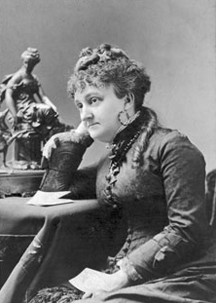
Myra Colby was born on February 12, 1831, in Manchester, Vermont. She was the daughter of Eben Colby and Abigail Willey. She lived with her family in Vermont and Western New York during her childhood. When she was twelve, the family moved to Schaumburg, Illinois. She attended schools in Kenosha, Wisconsin, and later enrolled in Elgin Female Seminary in Illinois. In 1852, Myra Colby married James B. Bradwell, and she became Myra Colby Bradwell. Two years later they moved to Memphis, Tennessee. James Bradwell was the head of a private school and Myra Bradwell became a teacher in that school. Bradwell completed her formal education by age 24 and taught herself law. She became a school teacher after she graduated. In 1855 they moved to Chicago, where James Bradwell was admitted to the Chicago Bar. He became a successful lawyer and judge. Myra Bradwell started her formal law training when her husband was accepted to the Illinois Bar. She apprenticed as a lawyer in her husband's office, and assisted him with research and legal writings. Complications arose because of coverture laws, which prohibited married women from holding property. The ability to hold property was necessary to become even a notary public.
In 1868, Bradwell founded the Chicago Legal News. With her husband's legal help, she persuaded the Illinois legislature to pass a special law, so that she could serve as both editor and business manager of the Chicago Legal News Company (it had other publications, and produced stationery and legal forms). Although the paper's offices were destroyed in the Great Chicago Fire of 1871, it continued to publish. The widely circulated paper published information about court opinions, laws, and court ordinances, and also had a muckraking function. Its reporters criticized corruption within the local bar and judiciary, and urged railroad regulation. Bradwell also was determined to improve women's status in society, so the paper included a column entitled "Law Relating to Women".
To support women's suffrage and efforts to gain employment, Myra Bradwell helped write the Illinois Married Women's Property Act of 1861. With Alta M. Hulett, another female lawyer, she wrote the Earnings Act of 1869; both bills allowed married women to control their earnings and property. In August 1869, a federal judge and state's attorney examined Bradwell's legal ability, pronounced her qualified, and suggested that the Illinois State Supreme Court Issue her a law license. But, her application was denied on the grounds that as a married woman, she could not enter into any legal contracts, as lawyers do in their profession. On February 5, 1870, the Illinois high court again denied her claim for a law license on the basis of sex.
Bradwell appealed to the United States Supreme Court, claiming that refusing to admit her to the bar because she was female violated her 14th Amendment rights. Despite the efforts of Senator Matthew Hale Carpenter, who argued on her behalf. The court's reasoning was fourfold: Women would not be allowed to practice the law. This would open the flood gates and many more women would want to follow in Bradwell's footsteps. Brutal cases would not be appropriate for a woman to handle. The state was worried about the effect women would have on the administration office. Thus in 1873, the Supreme Court also denied her admission to the Illinois bar because of her sex.
Meanwhile, in 1872, the Illinois legislature passed a law stating, "No person shall be precluded or debarred from any occupation, profession, or employment (except the military) on account of sex." Bradwell continued to work on the Chicago Legal News where she was the journal's publisher, business manager, and editor-in-chief. She also became an active member in the women's suffrage movement, serving as Secretary of the Illinois Women Suffrage Association.
Bradwell made no further proceedings to gain her license, although she assisted women in other states attempting to study law and gain law licenses in their states. She insisted that women's equality was a non-partisan issue. In Washington, D.C. Belva Lockwood lobbied Congress to pass a similar anti-discrimination bill to allow women to practice in federal courts. It was finally passed in 1879 and signed into law by President Rutherford B. Hayes.
In 1879, Lockwood became the first woman admitted to the U.S. Supreme Court bar, and in 1880 the first woman to argue a case before that body. She was later denied admission to the Virginia bar and in 1893 the United States Supreme court refused to force Virginia to admit her, citing its decision in Bradwell's case. Meanwhile, in 1890, the Illinois Supreme Court acted on its own motion and approved Bradwell's original application. On March 28, 1892, Bradwell received her license to practice before the United States Supreme Court
Myra Bradwell died of cancer on February 14, 1894, just four years after she was admitted to the bar. She is buried in Chicago's Rosehill Cemetery. Her daughter, Bessie Bradwell Helmer, continued what her mother started, graduating from the Union College of Law in 1882 and publishing the Chicago Legal News until 1925. Her son Thomas Bradwell also became a lawyer and managed the printing company. Myra Bradwell Elementary School in Chicago, Illinois was opened and named in her honor in 1889.


Add a comment to: Women in History- Myra Bradwell